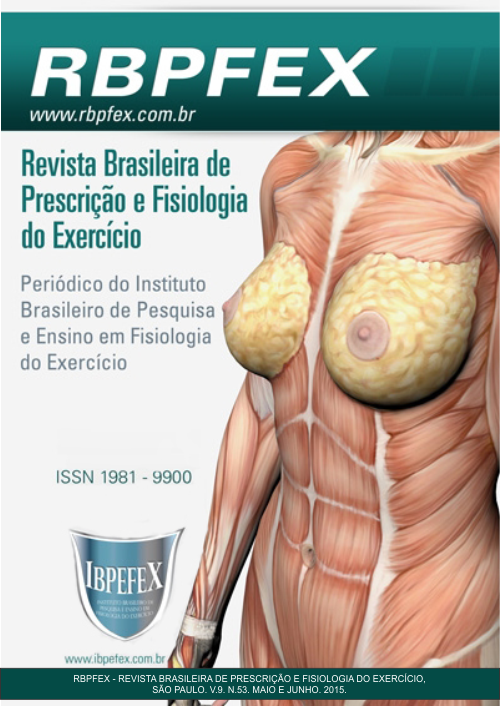Does muscle edema cell swelling neuromuscular partial occlusion superimposed training-induced depends on the intensity? A pilot study
Abstract
Introduction: Resistance training with partial vascular occlusion (PVO) is an alternative training method that provides improvements in structural and functional adaptations and in strength levels that have been associated with the achievement of acute responses of muscle cells swelling. However, the optimum intensity to induce this cell swelling in muscle is unknown. The aim of study was to compare the acute responses on the perimeter biceps brachii and body composition with different intensities of PVO. Methods: To this end, 10 healthy men (21 ± 1.3 years) were recruited to conduct a neuromuscular training consisting of 3 sets to muscle failure with PVO (130% of systolic blood pressure) at 30% and 70% 1RM separated by one week. Were assessed changes in the perimeter of the biceps, the percentage of muscle mass and water content. Results: The biceps circumference increased significantly (p ≤ 0.001) after PVO30% (34.16 ± 0.95 cm) and 70 % (34.06 ± 0.93 cm). The amount of water was increased (5.33 ± 30% 1.26 %, 6.02 ± 70% 1.53%) but the differences were not significant. Finally, no changes were recorded in the percentage of muscle mass. Conclusion: The findings support the use of neuromuscular training PVO with low intensity (30% 1RM) to generate acute muscle cell swelling in healthy young subjects. Future research should evaluate the acute effects of muscle edema with gold standard techniques such as ultrasound, and associated the acute responses with chronic adaptations of muscular hypertrophy.
References
-Burd, N.A.; West, D.W.D.; Staples, A.W.; Atherton, P.J.; Baker, J.M.; Moore, D.R.; Holwerda, A.M.; Parise, G.; Rennie, M.J.; Baker, S.K.; Phillips, S.M. Low-load high volume resistance exercise stimulates muscle protein synthesis more than high-load low volume resistance exercise in young men. PLoS ONE. Vol. 5. Num. 8. p. e12033. 2010.
-Chulvi, I. Resistance training combined with superimposed partial occlusion. A review. Revista Andaluza de Medicina del Deporte. Vol. 4. Num. 3. p. 121-128. 2011.
-Epley, B. Poundage chart. In: Boyd Epley Workout. Lincoln, NE. Body Enterprises. 1985. p. 86.
-Fash, C.H.A.; Loenneke, J.P.; Rossow, L.M.; Thiebaud, R.S.; Bemben, M.G. Methodological considerations for blood flow restricted resistance exercise. Journal of Trainology. Vol. 1. p. 14-22, 2012.
-Fry, A.C. The role of resistance exercise intensity on muscle fibre adaptations. Sports Medicine. Vol. 34. Num. 10. p. 663-679, 2004.
-Garber, C.E.; Blissmer, B.; Deschenes, M.; Franklin, B.; Lamonte, M.J.; Lee, I.-M.; Nieman, D.C.; Swain, D.P. Quantity and quality of exercise for developing and maintaining cardiorespiratory, musculoskeletal, and neuromotor fitness in apparently healthy adults: guidance for prescribing exercise. Medicine and Science in Sports and Exercise. Vol. 43. Num. 7. p. 1334-1359. 2011.
-Laurentino, G.; Ugrinowitsch, C.; Aihara, A.Y.; Fernandes, A.R.; Parcell, A.C.; Ricard, M.; Tricoli, V. Effects of strength training and vascular occlusion. International Journal of Sports Medicine. Vol. 29. p. 664-667. 2008.
-Loenneke, J.P.; Pujol, T.J. The use of occlusion training to produce muscle hypertrophy. Strength and Conditioning Journal. Vol. 31. Num. 3. p. 77-84. 2009.
-Marfell-Jones, M.; Olds, T.; Stewart, A.; Carter, L. International standards for anthropometric assessment. Potchefstroom, South Africa. ISAK. 2006.
-McGuigan, M.R.; Wright, G.A.; Fleck, S.J. Strength training for athletes: does it really help sports performance? International Journal of Sports Physiology and Performance. Vol. 7 Num. 1. p. 2-5. 2012.
-Pearson, S.J.; Hussain, S.R. A review of the mechanisms of blood-flow restriction resistance training-induced muscle hypertrophy. Sports Medicine. sep 24. 2014.
-Pollock, M.L.; Franklin, B.A.; Balady, G.J.; Chaitman, B.L.; Fleg, J.L.; Fletcher,B.; Limacher, M.; Piña, I.L.; Stein, R.A.; Williams, M.; Bazzarre, T. Resistance exercise in individuals with and without cardiovascular disease: Benefits, rationale, safety, and prescription an advisory from the committee on exercise, rehabilitation, andprevention, council on clinical cardiology, American Heart Association. Circulation. Vol. 101. p. 828-833. 2000.
-Pope, Z.K.; Willardson, J.M.; Schoenfeld, B.J. Exercise and blood flow restriction. Journal of Strength and Conditioning Research. Vol. 27. Num. 10. p. 2914-2926. 2013.
-Schoenfeld, B.J. The mechanisms of muscle hypertrophy and their application to resistance training. Journal of Strength and Conditioning Research. Vol. 24. Num. 10. p. 2857-2872. 2010.
-Schoenfeld, B.J. Potential mechanisms for a role of metabolic stress in hypertrophic adaptations to resistance training. Sports Medicine. Vol. 43. Num 3. p. 179-194. 2013.
-Schoenfeld, B.J.; Contreras, B. The muscle pump: potential mechanisms and applications for enhancing hypertrophic adaptations. Strength and Conditioning Journal. Vol. 36. Num. 3. p. 21-25. 2014.
-Teixeira, C.V.L.S. Métodos avançados de treinamento para hipertrofia. São Vicente. Edição do autor. 2014.
-Yasuda, T.; Loenneke, J.P.; Thiebaud, R.S.; Abe, T. Effects of blood flow restricted low-intensity concentric or eccentric training on muscle size and strength. PLoS ONE. Vol. 7. Num. 12. p. e52843. 2012.
Authors who publish in this journal agree to the following terms:
- Authors retain the copyright and grant the journal the right of first publication, with work simultaneously licensed under the Creative Commons Attribution License BY-NC which allows the sharing of the work with acknowledgment of the authorship of the work and initial publication in this journal.
- Authors are authorized to enter into additional contracts separately for non-exclusive distribution of the version of the work published in this journal (eg, publishing in institutional repository or book chapter), with acknowledgment of authorship and initial publication in this journal.
- Authors are allowed and encouraged to post and distribute their work online (eg, in institutional repositories or on their personal page) at any point before or during the editorial process, as this can bring about productive change as well as increase impact and impact. citation of published work (See The Effect of Free Access).






